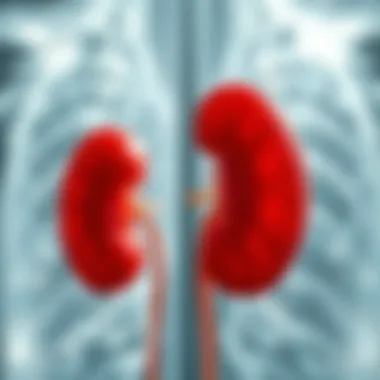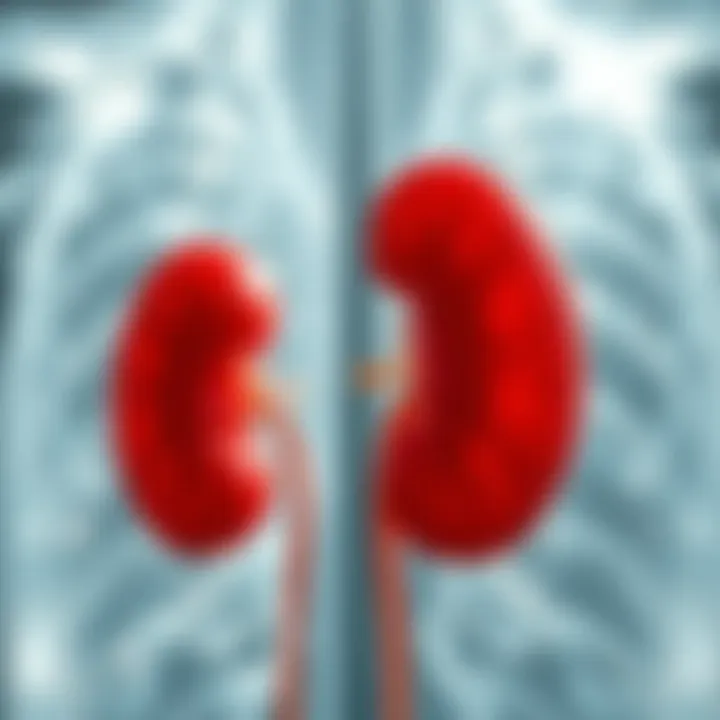Comprehensive Grading of Kidney Failure Explained


Intro
Kidney failure, a pressing health crisis, demands our attention as it greatly affects individuals' quality of life. The gradual decline of kidney function can lead to chronic conditions, culminating in end-stage renal disease. Understanding how this decline is graded is essential for effective treatment and management. Grading systems offer a framework for healthcare professionals and patients alike to gauge the severity of kidney impairment and to tailor interventions accordingly.
In this article, we will embark on a thorough exploration of the grading of kidney failure. Through a structured approach, we aim to clarify the stages of chronic kidney disease (CKD), outline diagnostic criteria, and underscore the significance of these grading systems in clinical settings. This narrative seeks to empower readers with the knowledge needed to navigate this complex landscape of kidney health, ultimately benefiting those who may find themselves or their loved ones facing such medical issues.
Prelude to Kidney Failure
Kidney failure, also known as renal failure, plays a crucial role in the landscape of healthcare today. Understanding its various aspects helps not just in managing patients struggling with the condition, but also in guiding preventive measures. As we explore kidney failure, we need to highlight its implications—both in clinical settings and public health narratives.
When kidneys fail to function properly, a cascade of complications can arise. These complications impact quality of life, necessitating a structured grading system to evaluate the severity of the condition. For instance, a clear definition and understanding of kidney failure provides a baseline for healthcare professionals and serves as a roadmap for treatment approaches. Not only do we shirk the idea of abstract medical terms, but engaging with the topic on a factual level fosters a deeper comprehension.
The importance of assessing renal function cannot be overstated, especially when we consider the increase in chronic kidney disease (CKD). Recognizing symptoms early can make a world of difference. For instance, subtle signs such as fatigue or swelling can indicate issues, and being proactive can halt progression. Furthermore, various grading systems aid in standardizing the classification of kidney failure, which aligns treatment strategies accordingly.
For readers—whether you're a student diving into nephrology, a researcher seeking to illuminate the unknown, or a healthcare professional—you’ll glean insights that not only inform but empower. Together, these elements will create a holistic approach to facing one of the significant health challenges of our time.
Definition of Kidney Failure
Kidney failure is characterized by the kidneys' inability to filter waste and excess fluid from the blood efficiently. What does this really mean? Simply put, when the kidneys aren't functioning as they should, toxins build up in the body, leading to hazardous levels of waste in the bloodstream. This can happen either suddenly, known as acute kidney injury (AKI), or gradually, referred to as chronic kidney disease (CKD).
In AKI, there’s often a specific precipitating factor, such as dehydration or a reaction to medications that leads to a rapid decline in kidney function. Conversely, CKD is a slow, progressive loss that often goes unnoticed until later stages. The implications of kidney failure extend far beyond the kidneys themselves, causing a ripple effect of health problems that necessitate urgent attention.
Epidemiology of Kidney Failure
The statistics surrounding kidney failure are quite alarming. According to the Centers for Disease Control and Prevention (CDC), approximately 37 million adults in the United States have CKD, and many don’t even know it. The term "silent disease" aptly applies here, and this underscores a vital importance - early detection is key.
Certain populations are considered high risk. For reasons spanning genetics, lifestyle choices, and socio-economic factors, groups like the elderly, individuals with hypertension, and those diagnosed with diabetes encounter higher rates of kidney failure. Awareness initiatives and screening programs are essential in these demographics to thwart progression.
Moreover, globally, the burden of kidney disease is expected to grow as populations age and lifestyle-related factors contribute to its prevalence. The World Health Organization (WHO) emphasizes the significance of integrating kidney health into broader public health strategies. Education about risk factors and preventive care can go a long way.
"Education about kidney health must become a priority, as kidney failure rates continue to rise globally."
Thus, understanding kidney failure isn’t just for medical professionals; it’s a collective responsibility that demands awareness and action across all sectors.
Types of Kidney Failure
Understanding the types of kidney failure is crucial for both healthcare professionals and patients alike. The way kidney failure manifests can significantly impact treatment options and patient outcomes. By discerning between different types, clinicians can tailor their approach, ensuring that the underlying cause is accurately addressed. This section delineates the two primary forms of kidney failure: Acute Kidney Injury and Chronic Kidney Disease, each with distinct characteristics and management strategies.
Acute Kidney Injury
Acute Kidney Injury (AKI) is a rapid decline in kidney function, often occurring over hours or days. The hallmark of AKI is its reversibility, but that doesn't mean it should be taken lightly. Various factors can trigger AKI, including:
- Dehydration leading to reduced blood flow to the kidneys.
- Obstructive uropathy, where an obstruction blocks urine flow and increases pressure on the kidneys.
- Nephrotoxic agents, such as certain medications or heavy metals, that can directly damage kidney tissue.
Recognition of AKI is essential because, if untreated, it can cascade into more severe complications, including chronic kidney disease or end-stage renal failure.
Addressing AKI often involves identifying and correcting the underlying cause. For instance, rehydration therapy may be sufficient for someone suffering from dehydration, while a patient with an obstruction might require surgical intervention. An early diagnosis typically leads to a better prognosis, making awareness of AKI symptoms, such as reduced urine output or swelling, vital for timely treatment.
Chronic Kidney Disease
Chronic Kidney Disease (CKD), on the other hand, is characterized by a gradual loss of kidney function over months or years. Unlike AKI, CKD is usually irreversible and escalates through five stages, from mildly reduced function to end-stage renal failure. The causes of CKD are multifactorial and may include:
- Diabetes Mellitus, as high blood sugar can damage blood vessels in the kidneys.
- Hypertension, which can lead to long-term damage to the renal arteries.
- Chronic glomerulonephritis, a condition that causes inflammation of the kidney's filtering units.
In the context of CKD, regular monitoring and management are key. This may involve lifestyle modifications, such as dietary changes and managing related health conditions.
Moreover, understanding CKD stages helps guide intervention strategies aimed at slowing progression. For instance, in early stages, patients might be advised to make specific lifestyle changes, while more advanced stages might warrant discussions around dialysis or kidney transplantation.
Recognizing the differences between AKI and CKD is not only beneficial for healthcare providers in planning treatment but also empowers patients with knowledge regarding their conditions. By staying informed about kidney health, patients can take proactive measures that could lead to improved outcomes.
"Identifying the type of kidney failure can significantly affect treatment options and patient journeys."
For more information on kidney health and related topics, consider visiting:
- National Kidney Foundation
- Cleveland Clinic - Kidney Diseases
- Centers for Disease Control and Prevention
Grading Systems in Kidney Failure


Grading systems in kidney failure play a pivotal role in the realms of diagnosis and treatment. These systems offer a structured way to classify the severity of kidney dysfunction, which can greatly influence patient management and outcomes. When healthcare professionals understand the intricacies of grading, they can make more informed decisions about treatment pathways, monitor disease progression, and tailor interventions specifically suited to the individual.
The importance here cannot be overstated. Having standardized grading allows for better communication among health care teams, enabling them to devise effective strategies based on the established guidelines. This ultimately leads to enhanced patient care, ensuring that interventions align with each patient’s specific circumstances. The grading also acts as a framework for clinical trials and research, grounding findings in a well-defined context.
Importance of Grading
Grading is essential for a multitude of reasons. Firstly, it provides benchmarks for evaluating kidney function, making it easier to identify trends over time. By classifying kidney failure, patients can be stratified according to their needs, optimizing resource allocation in clinical settings. Clinicians are better positioned to anticipate complications, leading to proactive management.
Moreover, grading can also shape patient education and engagement. When patients understand their condition, they are more likely to adhere to treatment plans. This awareness can foster stronger relationships between patients and their healthcare providers, translating into better health outcomes overall.
Common Grading Systems
Several grading systems exist to assess kidney failure, each with its unique features and applications. Let’s delve into the prominent ones:
Stages of Chronic Kidney Disease
The stages of chronic kidney disease, or CKD, offer a straightforward method to classify kidney function based on the Glomerular Filtration Rate (GFR). This staging ranges from G1, where kidney function is normal, to G5, indicating kidney failure requiring dialysis or transplantation.
One key characteristic of CKD staging is its focus on the GFR, which quantifies how well kidneys filter waste from the blood. This makes it a beneficial choice for practitioners, as it provides clear criteria for diagnosis and progression. Furthermore, this system emphasizes the importance of early detection, allowing for interventions that might delay or prevent deterioration.
However, despite its straightforwardness, the CKD staging system has disadvantages, such as the tendency to overlook other factors that might affect kidney health, like proteinuria or structural abnormalities.
Modification of Diet in Renal Disease (MDRD) Study Equation
The MDRD study equation is pivotal in assessing kidney function. This equation calculates the GFR from serum creatinine levels, age, gender, and race, making it a staple in renal research and clinical practice.
The key characteristic of the MDRD equation lies in its comprehensive approach to estimating GFR. By accounting for multiple variables, it provides a more personalized estimation of kidney function, which is vital for patient management. Its widespread use in clinical settings underscores its significance.
However, it’s worth noting that the MDRD equation may underestimate GFR at higher levels of kidney function, potentially leading to misclassification in patients with only mild renal impairment. Therefore, while it is helpful, understanding its limitations is crucial.
Kidney Disease: Improving Global Outcomes (KDIGO)
KDIGO guidelines represent an international effort to enhance the outcomes for patients with kidney diseases. These guidelines integrate various factors in grading kidney disease, supporting a holistic view of patient assessment. They emphasize the relation between the cause of kidney failure, its severity, and the management plans that should follow.
A key feature of the KDIGO system is its comprehensive nature. It doesn’t just take GFR into account but also includes factors like albuminuria and potential risk conditions. This approach has gained popularity, as it adds dimension to the understanding of kidney health.
However, the breadth of KDIGO can also be seen as a double-edged sword. The complexity may confuse some practitioners, especially when rapid decision-making is required. But when used appropriately, it leads to well-rounded patient care.
In summary, each grading system offers distinct advantages and certain challenges. Understanding these nuances is essential for healthcare professionals to effectively navigate the complex landscape of kidney failure assessment.
Evaluating Kidney Function
Evaluating kidney function is a crucial step in understanding kidney health and the extent of any dysfunction. This evaluation goes beyond just diagnosing problems; it plays an integral role in shaping treatment strategies and predicting patient outcomes. Accurate assessment provides a clearer picture of how well the kidneys are filtering waste and managing electrolytes, which is essential in tailoring individual patient management plans.
Various methods exist to assess kidney function, and these methods fall broadly into two categories: laboratory tests and imaging techniques. Each approach brings its own set of benefits and considerations.
Laboratory Tests for Assessment
Serum Creatinine Levels
Serum creatinine levels offer a direct gauge of kidney performance, reflecting the kidney's ability to clear creatinine, a waste product from muscle metabolism, from the blood. This measure is both simple and widely used in clinical practice, making it nearly ubiquitous in routine blood tests. A key characteristic of serum creatinine levels is their correlation with glomerular filtration rate (GFR), helping clinicians infer kidney function.
One benefit of this test is its availability and ease of interpretation. However, it does have limitations. For instance, factors like muscle mass, diet, and age can influence results, thus sometimes obscuring true kidney function. The unique aspect here is that while elevated levels indicate dysfunction, normal levels don’t always guarantee healthy kidney activity, particularly in early-stage impairments.
Glomerular Filtration Rate Calculation
The Glomerular Filtration Rate (GFR) calculation is perhaps the gold standard in assessing kidney function. GFR estimates how much blood passes through the glomeruli each minute, delivering important insights into how efficiently the kidneys are filtering waste. This calculation incorporates serum creatinine levels along with factors such as age, gender, and race, providing a more nuanced picture than creatinine alone.
What sets GFR apart is its ability to allow for a standardized assessment, enhancing comparability across individuals. While it remains a reliable measure, inaccuracies can surface based on estimation formulas, particularly in cases involving extremes of muscle mass or very young or old patients. Therefore, it’s essential to consider these variables when interpreting GFR results.
Urinalysis
Urinalysis is a key diagnostic tool that evaluates various components of urine, including protein, glucose, and red or white blood cells. This test can flag potential kidney issues, such as proteinuria or hematuria, which are signs of underlying kidney pathology. One of the hallmarks of urinalysis is how it can provide immediate feedback on renal health, making it a quick screening tool.
Its unique feature lies in its multifaceted insights—beyond kidney function assessments, it can reveal systemic health issues, like diabetes or infections. A downside, however, is that urinalysis might not indicate the degree of kidney impairment, requiring follow-up tests for comprehensive evaluation.
Imaging Techniques


Ultrasound in Kidney Evaluation
Ultrasound provides a non-invasive visual assessment of the kidneys, allowing for the evaluation of size, structure, and any obstructions or abnormalities. The advantage of ultrasound lies in its safety—it uses sound waves rather than radiation, making it suitable for repeated use. A key characteristic is its ability to detect renal masses, cysts, and fluid collections, which can be pivotal in cases of kidney failure.
However, it does have its limitations. Ultrasound can miss smaller lesions and may not provide functional information, such as how well the kidneys are actively filtering blood, necessitating further testing to complement its findings.
CT Scans and MRIs
CT scans and MRIs are advanced imaging techniques that build detailed, high-resolution images of the kidneys and surrounding structures. These scans can identify abnormalities that ultrasound might overlook, such as kidney stones or tumors. One of the significant advantages of CT and MRI is their superior capabilities in visualizing kidney anatomy and pathology.
Nonetheless, they do come with downsides. CT scans involve exposure to ionizing radiation, posing risks for certain patient groups, while MRIs can be constrained by their cost and accessibility. Plus, the time involved in these procedures can sometimes delay immediate clinical decision-making, making them more suitable for complex cases rather than standard evaluations.
Overall, evaluating kidney function through various laboratory tests and imaging techniques is imperative for proper diagnosis and management of kidney health. Each method offers unique insights, helping clinicians to piece together a comprehensive picture of a patient’s renal status. By understanding these evaluation techniques, medical professionals can make more informed decisions regarding treatment and patient care.
Clinical Implications of Grading
Understanding the grading of kidney failure is crucial not only for proper patient management but also for enhancing treatment outcomes. The implications of grading extend beyond mere categorization; they fundamentally shape the clinical decisions made regarding therapy. Each grade of kidney failure indicates a particular severity, which correlates with specific treatment protocols and prognosis.
Grading systems assist healthcare providers in assessing the functioning status of the kidneys, which in turn influences various aspects of patient care. Precise grading helps streamline the decision-making process related to treatment paths, from medications to the need for dialysis or kidney transplant evaluation. With a clearer grasp of a patient's condition, practitioners can tailor their approaches, ultimately leading to more personalized care.
Treatment Decisions
When it comes to managing kidney failure, treatment decisions hinge on accurate grading. The specific treatments can be drastically different depending on whether a patient is in the early stages of chronic kidney disease or facing end-stage renal failure.
Pharmacological Interventions
Pharmacological interventions play an essential role in managing kidney failure. The main focus of these medications is to halt the progression of the disease and manage associated complications. Drugs such as ACE inhibitors and angiotensin receptor blockers are particularly beneficial. They help reduce the additional strain on kidneys by controlling blood pressure and minimizing protein loss in urine.
One key characteristic of pharmacological interventions is their ability to be tailored to the specific stage of kidney failure. For instance, patients in the initial stages may require less aggressive treatment compared to those in the later stages, where the situation is more critical. The unique feature of pharmacological options is their dual capacity - not only do they manage symptoms, but they can also improve long-term outcomes when used appropriately.
However, there are advantages and disadvantages to consider. While these medications can be effective, they might not be suitable for all patients—especially those with comorbidities such as heart disease, making it pivotal for physicians to weigh the risks and benefits of each medication individually.
Dialysis Considerations
Dialysis is often a necessary intervention for those in advanced stages of kidney failure. It acts as a critical lifeline, replacing the filtering function of the kidneys. Key characteristic here is its two forms: hemodialysis and peritoneal dialysis. Each has its own set of risks, routines, and patient preferences, which must be factored into treatment plans.
The benefits of dialysis are clear; it does essentially perform the job kidneys can no longer do, helping to maintain homeostasis in the body by removing toxins, balancing electrolytes, and managing fluid overload. Another unique feature of dialysis is the adaptability in scheduling, allowing patients some control over their treatment options.
Nonetheless, it’s not without disadvantages. Dialysis can often be demanding in terms of time and lifestyle adjustments, not to mention its potential risks such as infection or cardiovascular complications.
Transplant Evaluation
When kidney failure reaches an advanced stage, transplant evaluation becomes a critical consideration. The process involves assessing if a patient is a suitable candidate for a kidney transplant. This is vital, as not every patient will be eligible due to factors like age, overall health, and the presence of other medical conditions.
One key characteristic of transplant evaluation is the rigorous criteria these individuals must meet. A successful transplant can significantly enhance a patient's quality of life and longevity. The unique feature here is the potential for a complete recovery of kidney function, which offers hope that no longer relying on dialysis, the patient can return to a more normal lifestyle.
However, challenges exist. The limited availability of donor organs is a fundamental concern. The long wait times and the need for lifelong immunosuppression also pose significant drawbacks that must be thoroughly discussed with the patient.
Prognostic Value of Grading
The grading of kidney failure offers profound prognostic value. It not only guides treatment but also provides insight into expected patient outcomes. Understanding the prognosis assists in delivering more informed discussions about care goals, quality of life, and end-of-life options if necessary.
By equipping healthcare professionals with detailed information on the severity of the disease, they can better support their patients through tailored care plans. The more nuanced understanding of kidney grading can indeed change the trajectory of treatment pathways and outcomes for many.
Challenges in Kidney Failure Assessment
Assessing kidney failure is a complex process riddled with challenges that can significantly impact patient outcomes. Understanding these challenges is crucial for improving diagnostic accuracy and informing treatment strategies. A keen focus on the limitations that exist within current grading systems can allow healthcare professionals to address gaps and enhance care for patients suffering from kidney issues.
Limitations of Current Grading Systems
Current grading systems for kidney failure, while fundamentally important, are not without their shortcomings. The Chronic Kidney Disease (CKD) stages, for instance, rely heavily on a few key metrics such as serum creatinine and glomerular filtration rate (GFR). While these measures can give a snapshot of kidney health, they do not fully encapsulate the nuances of kidney function. There are several reasons why current systems may fall short:
- Over-reliance on Serology: Many grading systems depend predominantly on serum creatinine levels. However, these levels can be misleading in certain populations, such as the elderly or those with muscularity differences, leading to under or over-estimation of kidney function.
- Inadequate Reflection of Symptoms: Grading systems do not often correlate well with a person’s clinical symptoms or overall wellbeing, which can vary widely among patients.
- Static Nature: These systems tend to be static, providing a snapshot rather than tracking the dynamic progression of kidney disease. Chronic Kidney Disease can fluctuate, and patients might not fit neatly into a single stage for long.
"Current grading systems can sometimes appear to create more confusion than clarity, particularly when applied to diverse patient populations."
The emphasis solely on quantitative measures can obscure more qualitative aspects of patient care. The disconnect between laboratory values and a patient's day-to-day reality is concerning. This inadequacy can lead doctors to miss out on crucial information, as subjective experiences of patients can reveal complications not readily apparent in test results.


Need for Standardization
The lack of standardization across grading systems further complicates kidney failure assessment. Different systems might employ varying criteria, leading to inconsistencies in diagnosis and treatment. Here are few key points supporting the need for standardized measures:
- Cross-institutional Variability: Without a common language or set of criteria, patients may receive different diagnoses and treatment recommendations based solely on where they seek care. This discrepancy can jeopardize patient safety and satisfaction.
- Comparative Effectiveness: A standardized approach allows researchers to effectively compare clinical outcomes across studies and institutions. This is important for future research aimed at improving treatments and guidelines.
- Education and Training: Standardized systems can better inform and train healthcare providers, fostering a clearer understanding of kidney failure grading and its implications in patient care.
- Integrated Care: When different specialties utilize the same grading framework, it encourages a more integrated approach to patient health. Such collaboration can improve care quality and efficiency, ultimately benefiting patients.
Future Directions in Kidney Failure Grading
With kidney failure becoming a growing concern in today's health landscape, exploring future directions in its grading is indispensable. This section sheds light on promising pathways that could transform the approach to assessing this critical condition, highlighting the integration of innovative biomarkers and technology. Incorporating cutting-edge developments into grading systems can enhance accuracy in diagnosis and management, ultimately improving patient outcomes.
Innovative Biomarkers
In an age where precision medicine is gaining traction, the search for innovative biomarkers in kidney failure remains vital. Traditional methods often rely on serum creatinine levels or glomerular filtration rates as indicators of kidney function. However, these measures can reflect kidney status only after substantial damage has been done.
Emerging biomarkers such as neutrophil gelatinase-associated lipocalin (NGAL) and kidney injury molecule-1 (KIM-1) offer significant advantages. These markers can potentially signal early kidney injury, providing clinicians with a window of opportunity for intervention. By identifying kidney dysfunction sooner, there’s a chance to halt or even reverse the progression of failure.
For instance, applications like urinary biomarkers exhibit promise in distinguishing acute from chronic kidney issues. As research evolves, integrating these biomarkers into routine assessments can revolutionize how grading systems operate, making them far more sensitive and specific.
"Innovative biomarkers can change the game in kidney failure assessment, enabling more timely treatment and better patient outcomes."
Encouragement toward multi-biomarker panels, which combine several indicators, is another forward-looking approach. These panels can help create a more comprehensive picture of kidney health and disease severity, underscoring the need for collaboration between researchers and clinicians to validate these markers in diverse populations.
Integrating Technology in Assessment
The integration of technology in assessing kidney function is no longer a futuristic idea; it is on the verge of becoming mainstream. Telemedicine, artificial intelligence, and machine learning are starting to have an impact. These technologies can refine grading systems by analyzing complex datasets more efficiently and accurately than human practitioners alone.
Leveraging machine learning algorithms, for example, can lead to predictive analytics that assess risk more precisely. By processing historical patient data, these systems learn to identify characteristics associated with various stages of kidney failure. Such predictive tools could enable providers to make informed choices tailored to individual patients, moving care from a reactive to a proactive stance.
Furthermore, mobile health applications are becoming game changers in real-time monitoring. Patients can keep track of their blood pressure, weight, and symptoms, feeding this data into electronic health records for ongoing evaluation by healthcare professionals. Such systems not only bolster patient engagement but also facilitate timely interventions that could mitigate serious complications.
As we delve deeper into applying these technological innovations, the focus remains on enhancing the overall effectiveness of kidney failure grading systems. Improved grading not only empowers healthcare providers but also enhances the patient experience through personalized care plans.
The End
The conclusion of this article serves as a focal point, tying together the discussions on kidney failure grading. Throughout the sections, we have explored the complexity of kidney failure and the significance of grading systems, and it becomes evident that understanding these systems is not merely an academic exercise but a vital aspect of real-world medical practice.
Importance of Grading Systems
The grading systems for kidney failure, such as the Stages of Chronic Kidney Disease and the KDIGO guidelines, offer structured approaches to assess the severity of a patient’s condition. This categorization not only aids clinicians in making informed decisions regarding treatment but also helps in predicting outcomes. By utilizing these grading systems, healthcare professionals can tailor interventions to the specific stage of disease, ultimately enhancing patient care.
Clinical Relevance
Recognizing the stage of kidney failure is crucial for optimal management. For instance, early-stage chronic kidney disease may only require lifestyle modifications and monitoring, whereas advanced stages could necessitate more aggressive treatments or even dialysis. Thus, the grading process directly impacts the strategies that clinicians employ—underscoring its importance within clinical settings.
Future Considerations
Moreover, as the healthcare landscape continues to evolve, the integration of innovative biomarkers and technology into kidney grading presents a promising frontier. These advancements could lead to more precise assessments of kidney function, facilitating timely interventions and possibly improving patient outcomes. It brings to mind the potential cultural shift in how kidney disease is viewed and managed.
"Understanding the stages of kidney failure can lead to better health decisions and a proactive approach to treatment"
This highlights a key benefit of organizational grading systems: empowering patients and clinicians alike to engage meaningfully in the management of chronic kidney disease.
Final Thoughts
Resources for further reading include:
As we step forward into the future of kidney health, the ongoing importance of robust grading systems will remain paramount in shaping effective treatment regimens and improving outcomes for those affected by kidney diseases.
Importance of References in This Article
The references selected for this article provide a backbone for evidence-based insights. When dealing with a complex and multifaceted condition such as kidney failure, having credible sources is paramount. Here are some specific elements that underscore the importance of references:
- Credibility: Citing peer-reviewed journals, research studies, and authoritative texts gives weight to the information presented. This ensures that the readers can trust the data and findings discussed throughout this article.
- Context: Kidney failure impacts millions globally, and the grading systems evolve with new research. Using up-to-date references helps contextualize the information and aligns it with the current understanding and practices.
- Evidence-Based Practice: Healthcare professionals primarily rely on research-backed information for effective treatment decisions. Having solid references allows healthcare practitioners to draw from validated studies for better patient outcomes.
Key Benefits of Using Reliable References
- Enhanced Understanding: Readers benefit from clear explanations that are appropriately supported. This creates a more engaging and informative experience.
- Facilitates Further Research: References often serve as stepping stones for readers who wish to delve deeper into the topic, guiding them to additional resources.
- Informed Decision Making: Clinicians and researchers who reference the material can make better-informed decisions, as they draw on verified research rather than anecdotal evidence.
Considerations About References
It's important to evaluate the credibility of sources critically. Not all published literature is of the same caliber. Here are some considerations:
- Authorship and Publication: Check if the authors are experts in nephrology or related fields and confirm whether the study is published in a reputable journal.
- Methodology: Reliable studies should have clear and replicable methodologies, providing transparency on how data was obtained and analyzed.
- Date of Publication: In medical fields, advancements happen quickly. Always aim for the most current publications to ensure the information is relevant.
Finding quality references can seem daunting at first, especially among the mountain of information available online. Resources such as PubMed, Google Scholar, and National Kidney Foundation serve as excellent starting points.
"The right source can illuminate dark corners of understanding, making even the complex seem manageable."
Ultimately, references in this article should not only support the content but also empower readers, enabling them to approach kidney failure and its assessment with renewed knowledge and confidence.



